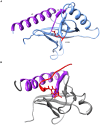Structural and population-based evaluations of TBC1D1 p.Arg125Trp
- PMID: 23667688
- PMCID: PMC3646766
- DOI: 10.1371/journal.pone.0063897
Structural and population-based evaluations of TBC1D1 p.Arg125Trp
Abstract
Obesity is now a leading cause of preventable death in the industrialised world. Understanding its genetic influences can enhance insight into molecular pathogenesis and potential therapeutic targets. A non-synonymous polymorphism (rs35859249, p.Arg125Trp) in the N-terminal TBC1D1 phosphotyrosine-binding (PTB) domain has shown a replicated association with familial obesity in women. We investigated these findings in the Avon Longitudinal Study of Parents and Children (ALSPAC), a large European birth cohort of mothers and offspring, and by generating a predicted model of the structure of this domain. Structural prediction involved the use of three separate algorithms; Robetta, HHpred/MODELLER and I-TASSER. We used the transmission disequilibrium test (TDT) to investigate familial association in the ALSPAC study cohort (N = 2,292 mother-offspring pairs). Linear regression models were used to examine the association of genotype with mean measurements of adiposity (Body Mass Index (BMI), waist circumference and Dual-energy X-ray absorptiometry (DXA) assessed fat mass), and logistic regression was used to examine the association with odds of obesity. Modelling showed that the R125W mutation occurs in a location of the TBC1D1 PTB domain that is predicted to have a function in a putative protein:protein interaction. We did not detect an association between R125W and BMI (mean per allele difference 0.27 kg/m(2) (95% Confidence Interval: 0.00, 0.53) P = 0.05) or obesity (odds ratio 1.01 (95% Confidence Interval: 0.77, 1.31, P = 0.96) in offspring after adjusting for multiple comparisons. Furthermore, there was no evidence to suggest that there was familial association between R125W and obesity (χ(2) = 0.06, P = 0.80). Our analysis suggests that R125W in TBC1D1 plays a role in the binding of an effector protein, but we find no evidence that the R125W variant is related to mean BMI or odds of obesity in a general population sample.
Conflict of interest statement
Figures


Similar articles
-
R125W coding variant in TBC1D1 confers risk for familial obesity and contributes to linkage on chromosome 4p14 in the French population.Hum Mol Genet. 2008 Jun 15;17(12):1798-802. doi: 10.1093/hmg/ddn070. Epub 2008 Mar 5. Hum Mol Genet. 2008. PMID: 18325908
-
The TBC1D1 gene: structure, function, and association with obesity and related traits.Vitam Horm. 2013;91:77-95. doi: 10.1016/B978-0-12-407766-9.00004-3. Vitam Horm. 2013. PMID: 23374713 Review.
-
TBC1D1 regulates insulin- and contraction-induced glucose transport in mouse skeletal muscle.Diabetes. 2010 Jun;59(6):1358-65. doi: 10.2337/db09-1266. Epub 2010 Mar 18. Diabetes. 2010. PMID: 20299473 Free PMC article.
-
Does a short breastfeeding period protect from FTO-induced adiposity in children?Int J Pediatr Obes. 2011 Jun;6(2-2):e326-35. doi: 10.3109/17477166.2010.490269. Epub 2010 Sep 23. Int J Pediatr Obes. 2011. PMID: 20863147
-
Visceral adiposity and inflammatory bowel disease.Int J Colorectal Dis. 2021 Nov;36(11):2305-2319. doi: 10.1007/s00384-021-03968-w. Epub 2021 Jun 9. Int J Colorectal Dis. 2021. PMID: 34104989 Review.
Cited by
-
AKT and AMP-activated protein kinase regulate TBC1D1 through phosphorylation and its interaction with the cytosolic tail of insulin-regulated aminopeptidase IRAP.J Biol Chem. 2018 Nov 16;293(46):17853-17862. doi: 10.1074/jbc.RA118.005040. Epub 2018 Oct 1. J Biol Chem. 2018. PMID: 30275018 Free PMC article.
-
Isoform-specific AMPK association with TBC1D1 is reduced by a mutation associated with severe obesity.Biochem J. 2018 Sep 25;475(18):2969-2983. doi: 10.1042/BCJ20180475. Biochem J. 2018. PMID: 30135087 Free PMC article.
-
Deletion of the Rab GAP Tbc1d1 modifies glucose, lipid, and energy homeostasis in mice.Am J Physiol Endocrinol Metab. 2015 Aug 1;309(3):E233-45. doi: 10.1152/ajpendo.00007.2015. Epub 2015 May 26. Am J Physiol Endocrinol Metab. 2015. PMID: 26015432 Free PMC article.
-
Alcohol binding in the C1 (C1A+C1B) domain of protein kinase C epsilon.Biochim Biophys Acta. 2015 Nov;1850(11):2368-76. doi: 10.1016/j.bbagen.2015.07.005. Epub 2015 Jul 22. Biochim Biophys Acta. 2015. PMID: 26210390 Free PMC article.
-
Novel functions of CCM1 delimit the relationship of PTB/PH domains.Biochim Biophys Acta Proteins Proteom. 2017 Oct;1865(10):1274-1286. doi: 10.1016/j.bbapap.2017.07.002. Epub 2017 Jul 8. Biochim Biophys Acta Proteins Proteom. 2017. PMID: 28698152 Free PMC article.
References
-
- Stunkard AJ, Foch TT, Hrubec Z (1986) A twin study of human obesity. JAMA 256: 51–54. - PubMed
-
- Stunkard AJ, Harris JR, Pedersen NL, McClearn GE (1990) The body-mass index of twins who have been reared apart. N Engl J Med 322: 1483–1487. - PubMed
-
- Loos RJ, Bouchard C (2003) Obesity — is it a genetic disorder? J Intern Med 254: 401–425. - PubMed
-
- Stone S, Abkevich V, Russell DL, Riley R, Timms K, et al. (2006) TBC1D1 is a candidate for a severe obesity gene and evidence for gene/gene interaction in obesity predisposition. Hum Mol Genet 15: 2709–2720. - PubMed
Publication types
MeSH terms
Substances
Grants and funding
LinkOut - more resources
Full Text Sources
Other Literature Sources

